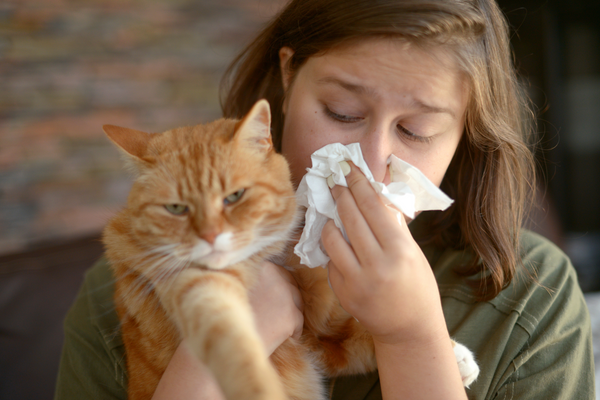Can You Have a Cat If You Have Allergies?

Having any kind of allergy can be frustrating – but being allergic to something living in your home can be even worse. However, if you’re allergic to cats, it doesn’t always mean you can never have one. The benefits of having a feline companion usually outweigh the drawbacks of allergies. If you have your heart set on a cat, there are ways to do it. We have the details for you here.
What Causes Allergies to Cats?
Allergies to pets are prevalent, affecting millions of Americans. In the U.S., as many as 30% of people with allergies have allergic reactions to cats and dogs, with cat allergies being twice as common as dog allergies.
According to the Asthma and Allergy Foundation of America (AAFA), if you have a cat allergy, your body’s immune system reacts to proteins in the pet’s urine, saliva, or dander.
The most common cat allergen is cat dander, followed by a glycoprotein known as Fel d 1, which is secreted by the cat’s sebaceous glands and then transmitted by their saliva – often when it gets into the fur as they groom themselves.
Pet allergens are everywhere and can even be found in homes and other environments where animals have never been present. This is because the allergens are incredibly lightweight, and particles can easily become airborne. Once airborne, these tiny particles can stay suspended in the air for at least 30 minutes or longer. People can also carry pet allergens on their clothing or shoes. Pet allergens – including cat allergens – will not lose their strength for a long time. In fact, the allergens can remain at high levels for several months and can collect on furniture, clothing, walls, mattresses, drapes, and other surfaces. Cat hair itself is not an allergen. However, it can collect allergens like dust and pollen and cause allergy symptoms. In those cases, the allergy is to the dust or pollen, not the cat.
Although anyone can develop allergies at any time, some families are more prone to them. While allergies to a specific allergen aren’t inherited, the overall likelihood of developing allergies is increased when other family members have allergies.
Cat Allergy Symptoms
Symptoms of cat allergies vary from person to person. Some common cat allergy symptoms include:
- Itchy, red, watery eyes
- Nasal congestion
- Skin rash
- Sneezing
- Coughing
- Wheezing
- Runny/stuffy nose
In extreme cases, a severe allergic reaction can occur. This is known as anaphylaxis, in which the allergic individual may experience itching, hives, swelling, respiratory distress, shock, or even death.
Generally, symptoms will worsen when an allergy sufferer is exposed to more significant amounts of allergens or when several different types are present. Reducing exposure to all allergens can reduce the severity of symptoms.
Related: Why Are So Many People Allergic to Cats?
Are There Any Hypoallergenic Cat Breeds?
In short, no, there are no truly hypoallergenic cat breeds.
According to a study published in the European Journal of Allergy and Clinical Immunology, there are no allergen-free or hypoallergenic cats. The study also explains that allergen production can vary significantly among cats, noting that male cats have been shown to produce three to five times fewer allergens after they’ve been neutered. Similarly, female cats are generally known to produce fewer allergens.
That said, all cats are different, and it’s difficult to tell if a particular breed (or a particular cat) won’t cause a reaction. It can be helpful to talk to veterinarians or a local cat club (such as the Cat Fanciers’ Association) as you’re trying to decide which cat breed is the right fit for you. Once you’re ready to welcome a feline friend into your family, consider adoption from a local animal shelter or pet adoption event.
Additionally, some cats are considered better suited for people with allergies, such as those with minimal shedding and low grooming needs, including breeds like:
- Balinese
- Burmese
- Cornish Rex
- Devon Rex
- Javanese
- Ocicat
- Oriental Shorthair
- Russian Blue
- Siberian
- Sphynx
Managing Your Allergy to Cats
Out of other common allergens, like pollen, mold, dust mites, and animal dander, cat dander is the smallest. Since cat dander so easily becomes airborne and hangs out in the air for such long periods, those who are allergic can be constantly exposed to the allergen.
If not managed, pet allergy symptoms can lead to decreased quality of life, including difficulty sleeping and lack of energy. Fortunately, if you have cat allergies, you can take steps to reduce symptoms. Here are some tips on what to do before and after you bring your new pet home:
Before Bringing Your New Feline Companion Home:
- Before looking for your new pet, check with your doctor or allergist first and pinpoint precisely what causes your allergy. Most pet allergies are easily managed, but it’s worth a trip to the doctor to make sure your allergies aren’t severe before bringing a furry companion into your home. Your doctor may also recommend prescription allergy medication or over-the-counter options to help with your symptoms.
- Eliminate irritants from your home, including air fresheners, fragranced cleaning and laundry products, perfumes, and scented candles, all of which can exacerbate allergy symptoms and cause further respiratory inflammation.
- Reduce clutter around your home. Less clutter makes it easier to clean and get rid of allergens.
- Clear your home of as many allergens as possible, including dust mites and mold. You’ll experience fewer symptoms when your new pet comes home by reducing exposure to these other allergens. Here are a few ways to help combat allergens in your home:
- Start by thoroughly vacuuming furniture, carpet, pillows, and other soft surfaces with a HEPA vacuum to avoid recirculating allergens back into the air.
- If you haven’t recently treated soft surfaces for dust mites, apply DustMiteX to eliminate mites and control populations for the next six months.
- Apply the Anti-Allergen Solution to soft surfaces to neutralize lingering dust mite allergens. The solution can also be used to eliminate allergens from hard surfaces.
- Clean any moldy or mold-prone areas with Vital Oxide to destroy mold from its roots.
- Wash bedding, blankets, pillows, towels, washable throw rugs, and any existing pet beds with the Anti-Allergen Laundry Detergent to eliminate allergens.
After Bringing Your New Feline Companion Home:
- Avoid “dry” cleaning (brooms, feather dusters, dry dusting cloths), which can aerosolize cat dander. Instead, clean with damp supplies, such as lightly dampened microfiber cloths and mops which help trap and remove particles.
- Prepare to vacuum furniture, carpets, and other soft surfaces at least once weekly. To avoid recirculating cat dander in the air, use a vacuum cleaner with a HEPA filter to trap more of the particles. After vacuuming, spray soft surfaces with the Anti-Allergen Solution to neutralize any lingering cat dander.
- Limit your cat’s access to your bedroom. Airborne pet allergen levels have been found to be much higher in rooms where pets spend more of their time.
- When washing clothing, rugs, bedding, pet bedding, and other household washables, with our Anti-Allergen Laundry Detergent to remove allergens including dust mite waste, mold, smoke, pollen, and pet dander.
- Bathe pets regularly with our Anti-Allergen Pet Shampoo to remove allergens from their fur. Bathing a cat can be daunting the first time, but it is possible with a bit of patience and some treats.
Have questions about cat dander or other common indoor allergens? We have answers! The Ecology Works has been helping people with allergies and asthma since 1993. We can help you select the products you need to live a better, allergen-free life. Please feel free to Contact Us or message us on Facebook. No question is too small! We’re here to help.




